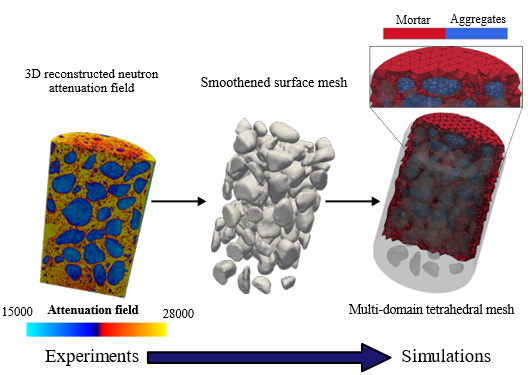From tomographic imaging to numerical simulations: an open-source workflow for true morphology mesoscale FE meshes
DOI:
https://doi.org/10.21809/rilemtechlett.2023.184Keywords:
Conformal Meshing, Concrete Mesostructure, Mesoscale Modelling, Neutron ImagingAbstract
Full-field techniques such as tomography are becoming progressively more central in the study of complex phenomena, in particular where spatiotemporal evolution is crucial, as in moisture transport or crack initiation in porous media. These techniques provide a unique insight in the local process whose quantification allows the improvement of our understanding and of the models describing them. Nevertheless, the model validation can be pushed further by attempting to explicitly represent the heterogeneities and simulate their role in the processes. Once validated, these models can be used to perform “virtual experiments”, and overcome the limitations of the experiments (e.g., sample size and number, fine control of the boundary and initial conditions). This study proposes a connection between tomography images and mesoscale models through a workflow that mainly employs open-source tools. This workflow is illustrated through the digitization of a Portland cement concrete sample, stemming from neutron tomographies and resulting in a numerical finite element mesh. The proposed workflow is flexible, allowing for the conversion of images from various sources, such as x-ray or neutron tomographies, to different numerical representations of the domain, such as finite element meshes or even a discrete domain required by discrete element methods, while preserving real morphologies with an accuracy proportionate to the specific need of the problem. Beside its generalizability, our method also offers automated labelling of the different domains and boundaries in both the volumetric and surface meshes, which is often necessary for assigning material properties and boundary conditions. Finally, the series of image, geometry and mesh processing steps described in this work are made available on a GitHub repository.

Downloads
Published
How to Cite
Issue
Section
License
Copyright (c) 2024 Hani Cheikh Sleiman, Murilo Henrique Moreira, Alessandro Tengattini, Stefano Dal Pont

This work is licensed under a Creative Commons Attribution 4.0 International License.
Authors retain copyright of the articles published in RILEM Technical Letters and grant the journal the right of first publication with open access. The work is simultaneously licensed under Creative Commons Attribution 4.0 International License (CC BY 4.0) that allows others to share and adapt the work under the following terms: 1) a proper attribution is given in a form of a reference to the original work's authorship and initial publication in RILEM Technical Letters (bibliographic record with the DOI link); 2) a link to the license is provided; 3) the changes (if any) are indicated.









